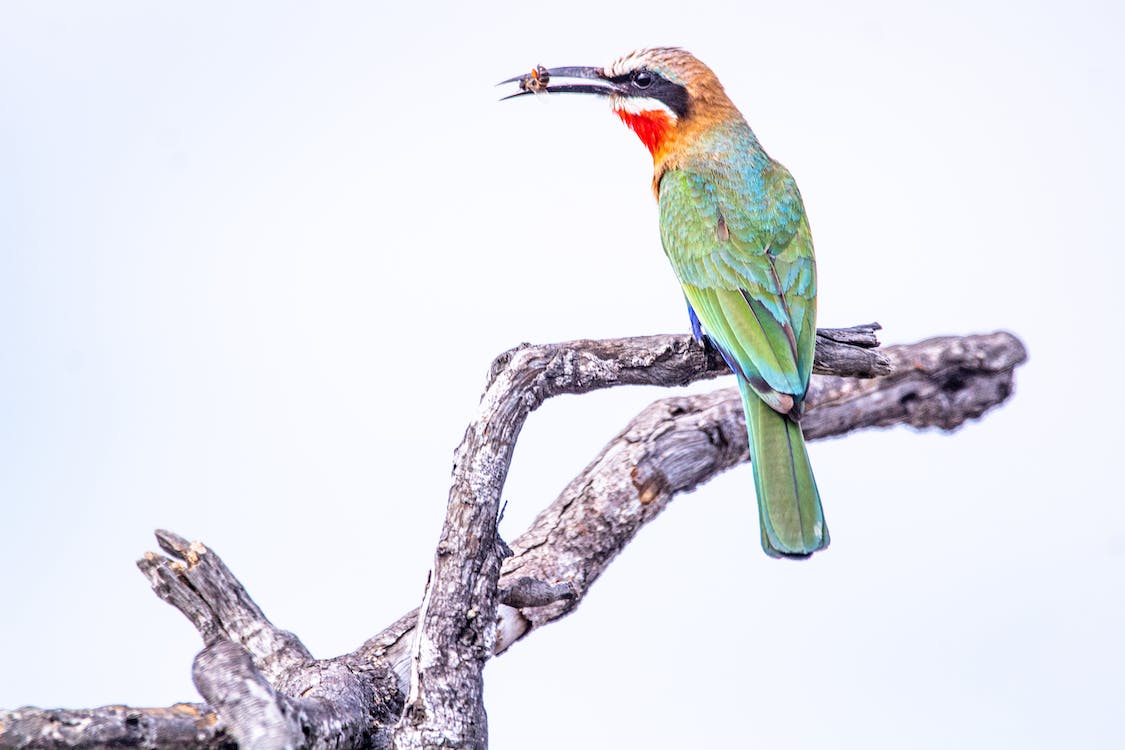It is a bee-eater bird with striking and colorful plumage, making it easily recognizable. Pairs and groups thrive in woodland near water sources, scrubs, and hillsides, especially along earthen mounds, where they form colonies of more up to 450 individuals. This bird species has one of the most intricate societies, involving families and clans.
Read further to know more about the White-fronted Bee-eater.
What is a White-fronted Bee-eater?
White-fronted Bee-eater (Merops bullockoides) is a species of bee-eater occurring widely in sub-equatorial regions of Africa. They are aesthetically-pleasing birds, yet their colorful plumage is not only a feast for human eyes, as they are incredible hunters and skilled in flight. These birds acquired a distinct ability to hunt insect prey, mostly bees, while in flight and consume them sans suffering from its agonizing sting.
Its seven levels of classification are as follows:
Kingdom: Animalia
Phylum: Chordata
Class: Aves
Order: Coraciiformes
Family: Meropidae
Genus: Merops
Species: M. bullockoides
White-fronted Bee-eater Physical Description
White-fronted Bee-eater is a vibrantly colored, slim bird, growing around 9 inches or 23 centimeters, and weighing about 35 grams. It is the only bee-eater in its range with a red-white throat. It has a greenish top with light brownish yellow underparts. This bird also has a black eye band, white forehead, a vibrant red throat, and a white line separating the throat from the beak. Meanwhile, their tails are square-ended.
Where can they be spotted?
White-fronted Bee-eaters thrive in sandy cliffs, wooded savannas, open scrubs, and grassland in sub-equatorial regions of Africa. They refrain from staying in dense forests. Their colony sites occur on almost vertical, faces of cliffs. Though, these birds often move to new sites a few months before the breeding season. Often, they forage about 4 to 7 kilometers or 2.5 to 4.4 miles from their nesting colony.
Interesting Facts You Should Know About the White-fronted Bee-eater
White-fronted Bee-eaters are insectivores, and their diet primarily consists of bees. Thus, the name. However, they may also consume other insect prey, depending on the availability of food source or the season. They employ two hunting techniques in catching their meals. These birds glide slowly from branches and drift shortly to catch prey or else, take fast hawking aerial strikes from lower trees and shrubs.
These birds have needle-sharp beaks, which are beneficial in catching their prey. It provides accuracy, preventing them from being stung by the insect. After they snatch their prey, they go back to their perch and ‘de-sting’ the insect. They pinch the victim to squeeze out all of its toxins or poison and then smash them against the branches to take the sting out.
While the process may seem long, these birds are undoubtedly skilled hunters as they one of the few species that are capable of this hunting method, which allows them to eat more variety of insects, unlike other insectivore bird species.
These birds are sedentary, which is why wings are more squared off and broader at the edges, as compared to the migrant species, which evolved to have more pointed and leaner wings beneficial for long flights.
White-fronted bee-eaters are extremely cooperative birds. They have a two-tier system, working hand-in-hand in raising the chicks. A family unit connects with one to two other groups of birds to create the second tier – a clan. The members of the clan visit each others’ nests and share all domestic tasks, from burrowing tunnels, incubating the eggs, tending the chicks, and defending themselves from rival groups. They also roost together, closely gathered on a tree branch, and even fly to and from the foraging grounds.
These birds are monogamous and will form life-long bonds with their partners. They dig tunnels on banks to serve as their nest without lining them with grass or twigs. The female lays a clutch of 2-5 eggs directly on the sand, which all the parents and the clan members incubate jointly for about 21 days. After hatching, their chicks will fledge in about 28 days.
Since they are common and widespread in their range, white-fronted bee-eaters are classified as a least concern species under the International Union for Conservation of Nature Red List.
WILDLIFE PARKS AND RESERVES WHERE THIS SPECIES IS FOUND:
ZAMBIA
ZIMBABWE
BOTSWANA
SOUTH AFRICA
BOTSWANA BIRDS | SOUTH AFRICA BIRDS
NAMIBIA BIRDS | ZAMBIA BIRDS | ZIMBABWE BIRDS

